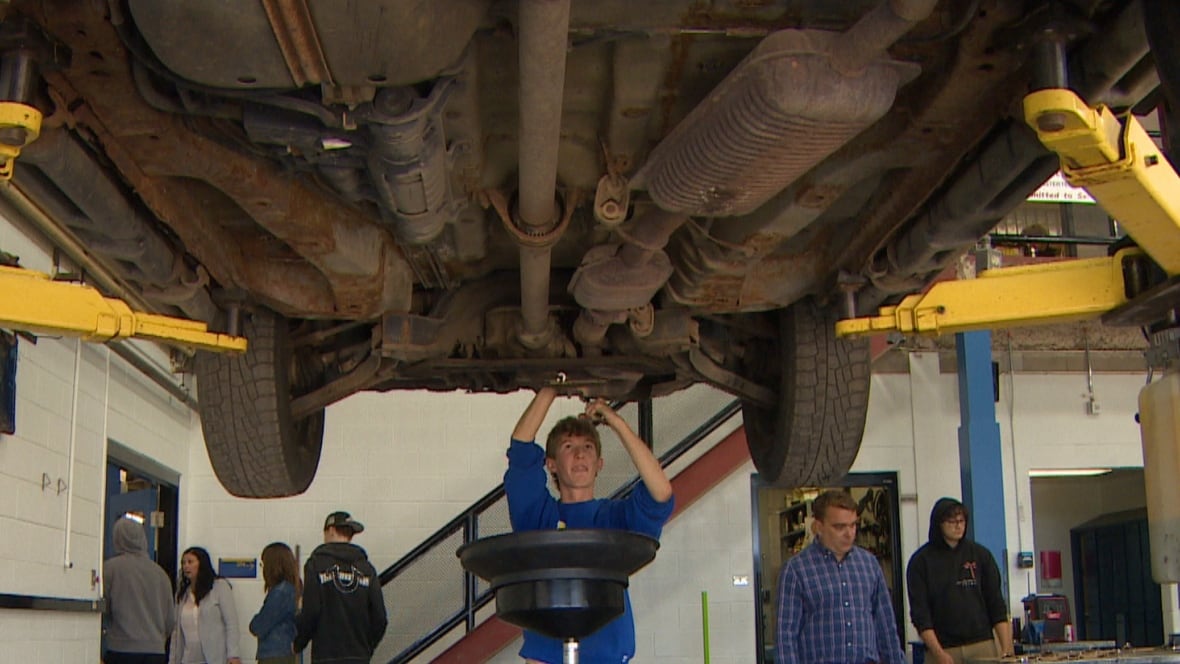Education
Alberta Launches 16 New Collegiate Programs to Boost Careers

Alberta has introduced sixteen new collegiate programs in schools across the province, offering students practical pathways to trades education and employment opportunities. These initiatives, funded by provincial resources, aim to equip students with essential skills while bridging the gap between high school and post-secondary education.
One notable success story is that of Liam Evans, a Grade 12 student at Bev Facey Community High School. This fall, the school launched its collegiate programming, which includes various vocational courses. Evans, who previously knew little about mechanics, secured an apprenticeship at a car dealership over the summer, crediting the collegiate program for helping him define his career aspirations. “It absolutely played a big role in what I wanted to do,” he stated.
The collegiate programs encompass a diverse range of subjects, including carpentry, welding, mechanics, cybersecurity, hair styling, and cooking. Jessica Smith, principal of the Elk Island Public Schools collegiate hub, noted that 89 students have enrolled this semester. “These kids have an opportunity to dabble,” Smith explained, highlighting the low-risk environment that allows students to explore various career paths.
Understanding Collegiate Programs
Collegiate programs are designed to provide students with early exposure to vocational training, allowing them to gain practical skills while still in high school. This initiative is particularly beneficial for students from various regions, including those commuting from Vegreville to attend classes at Bev Facey. The intent is to facilitate access to quality education and training closer to home.
The demand for skilled trades in Alberta has surged, according to Kevin McNichol, CEO of Prospective Human Services. He noted that many urban youth have not considered careers in trades despite the growing need for skilled workers in infrastructure projects across the country. “All the trades that are required to build all the housing that we’re talking about in our country, all the major infrastructure projects — all of it is in need,” McNichol emphasized.
Balancing Education and Costs
While the collegiate model is gaining traction, concerns about educational equity remain. Wing Li, communications director for the advocacy group Support Our Students Alberta, expressed hope that the focus on vocational training does not overshadow critical aspects of education, such as fostering critical thinking and personal development. “Education isn’t only about getting a job,” Li remarked.
The cost of enrolling in collegiate classes varies, ranging from $250 to $500. This fee structure could pose a barrier for some students. However, principal Smith and students argue that it is still more cost-effective compared to similar courses at post-secondary institutions. Successful transfer of dual credits could also lead to significant savings in the long run.
Some collegiate programs, such as the STEM charter school in Edmonton, offer career-focused education to all students from grades 7 to 12. Others, like Bev Facey, integrate collegiate programming within the traditional high school framework, providing students with additional options.
Looking forward, the Alberta government has earmarked $8 million for the next two fiscal years to expand collegiate programs further. In a statement, Education Minister Demetrios Nicolaides reaffirmed the government’s commitment to offering diverse educational choices, emphasizing the significance of collegiate programs in this vision.
As the Elk Island Public School Division plans to build a new school in Fort Saskatchewan, the focus will be on addressing local labour needs through specialized courses in power engineering, pipe fitting, and healthcare aid. For students like Liam Evans, these opportunities represent a meaningful enhancement to their educational experience. “It’s definitely a good way to improve your high school, not just sitting in a classroom for six hours a day writing stuff down,” he concluded.
-

 Science3 months ago
Science3 months agoToyoake City Proposes Daily Two-Hour Smartphone Use Limit
-

 Top Stories3 months ago
Top Stories3 months agoPedestrian Fatally Injured in Esquimalt Collision on August 14
-

 Health3 months ago
Health3 months agoB.C. Review Reveals Urgent Need for Rare-Disease Drug Reforms
-

 Technology3 months ago
Technology3 months agoDark Adventure Game “Bye Sweet Carole” Set for October Release
-

 World3 months ago
World3 months agoJimmy Lai’s Defense Challenges Charges Under National Security Law
-

 Lifestyle3 months ago
Lifestyle3 months agoVictoria’s Pop-Up Shop Shines Light on B.C.’s Wolf Cull
-

 Technology3 months ago
Technology3 months agoKonami Revives Iconic Metal Gear Solid Delta Ahead of Release
-

 Technology3 months ago
Technology3 months agoApple Expands Self-Service Repair Program to Canada
-

 Technology3 months ago
Technology3 months agoSnapmaker U1 Color 3D Printer Redefines Speed and Sustainability
-

 Technology3 months ago
Technology3 months agoAION Folding Knife: Redefining EDC Design with Premium Materials
-

 Business3 months ago
Business3 months agoGordon Murray Automotive Unveils S1 LM and Le Mans GTR at Monterey
-

 Technology3 months ago
Technology3 months agoSolve Today’s Wordle Challenge: Hints and Answer for August 19









